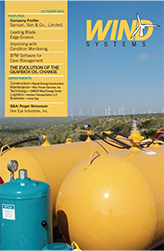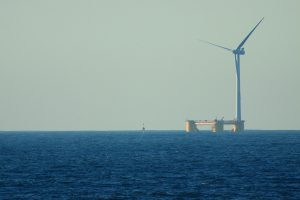It is the end of summer and I am finally taking a break after a busy summer building schedule. As I relax on the beach, I reflect on all the wind components that have been moved. Because of the economic and political environment it has been a robust season. And it is not over yet. Many open projects are still in process and will continue to be that way until the end of the year. But the season is changing and so logistically we have to change our approach to transporting equipment. As fall and early winter set in here are some things to consider:
Shorter days will have an impact on schedules. Less daylight translates into fewer hours on the road. Depending on the state, over-the-road permitting may change. What was acceptable in June may not be in October. At the delivery site, portable lighting may have to be brought in to assist in either loading or discharging cargo. This is also a consideration for ships discharging at ports. Do they have adequate lighting to work after sunset?
Weather becomes a factor, especially in the north as the season changes. Foul weather has to be planned for and staff and equipment have to be properly prepared. The risk of accident and injury is greater. It is critical that employees and vendors are thoroughly trained, and procedures and processes are in place and audited. Cold and wet weather can make seemingly routine tasks more difficult. Consider something as routine as climbing onto a trailer for lashing in the summer, becoming more difficult due to thicker clothing and slick conditions in the fall and winter.
Weather also has an effect on road conditions. Frost laws are applied differently depending on state regulation. Overweight cargo that was permitted in the summer may have to be rerouted due to these laws. When routing your cargo, take into consideration ports, rivers, channels and lakes closures because of either low water at the end of summer or early ice. This will also shift the volume of cargo towards southern ports, which will increase time and costs, forcing you to use less experienced terminals to handle project cargo.
Equipment maintenance is critical. Transport assets such as trucks, cranes, forklifts or other material handling equipment need to be winterized. The fall and winter seasons are hard on equipment. Things seem to break more often and take longer to fix. Plan for adequate spare parts and service personnel to meet your schedule. Remember that the type of equipment may change. Where as a normal tractor-trailer setup would handle the cargo in the summer, now due to poor conditions, lower geared power may be required for movers. This is especially true in ridgeline projects.
All of the above add time and cost to the project. These need to be recognized up front and accounted for. Adding weather days into the planning process helps mitigate costs. How does this happen? By recognizing weather days in advance you can negotiate lower rates and lessen demurrage with contractors at the time of contract negotiations. But let me point out, the approaching fall and winter season isn’t all doom and gloom for projects. As the summer season winds down, more and more transport capacity is freed up. This creates an opportunity for lower pricing. Also with more assets available, more assets may be applied to the project to shorten the overall lead-time. For example, if in the summer you could only find 18 blade trailers to service your project. Now 24 or 36 may be available in the fall or winter. It is a good time to bargain shop. For projects located in the south, the weather becomes more temperate, leading to better working conditions. It’s no fun loading cargo onto a rail car in Texas in July or working in the hold of a ship in New Orleans in August.
I have a few more days at the beach before I head back to the office and face the approaching fall. I am soaking in the last warm days in summer, but I am also thinking about the approaching season and wondering where my foul weather gear is stored and if my winter boots are weatherized.

































